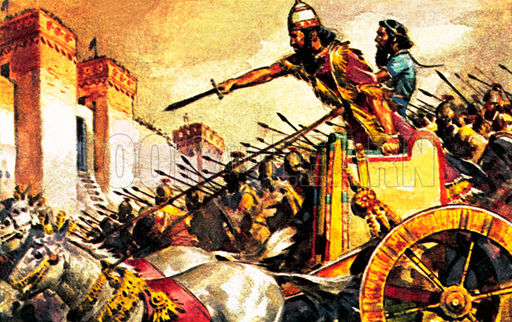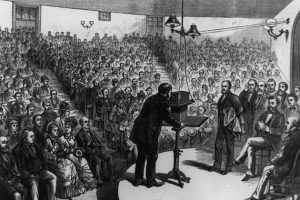The success of the Assyrian empire was not mere luck on the part of the Assyrian army. It was quite frankly anything but luck. They were considered the most efficient military force up until the time of their fall in 612 BCE. The Assyrians were known to be absolutely ruthless. Factors contributing to their success included their professionally trained army, their engineering skills, their well-developed tactics, and their all-important use of iron weaponry. Although use of iron for weaponry had already been capitalized on, the Assyrians are considered the first to take full advantage of the Iron Age.1
Previous to the use of iron, most weapons were made of bronze. Therefore, a majority of the Assyrians’ enemies were fighting with bronze weapons. The process for crafting these weapons out of iron required a quite different process than that of making bronze weapons. Iron, unlike bronze, needs to be heated and hammered. The Assyrians were lacking in resources and are believed to have been forced to master iron metallurgy rather quickly. Not only did making these weapons require new techniques, but also more time. Fortunately for the Assyrians, the use of iron increased the quality of armor as well as weaponry. While the use of iron made shields and helmets much heavier, it also allowed for greater protection.2

One of most notable weapons used by the Assyrians included the chariot. The chariot, originally a simple carriage drawn by donkeys, was introduced with horses by the Hyksos invaders of Egypt around 1700 BCE. The chariots were especially important for battlefield warfare because of their speed. Armor was most often worn by the chariot crews.3 Standard armor included a tightly fitted short sleeve jacket protecting the body and arms, as well as a loose skirt protecting the legs. The skirts were of different lengths; they could have been ankle length, thigh length, or slightly shorter. The full coat of armor was heavy, and for this reason, the armor was made into separate sections, making the weight better distributed.4 In addition to the body armor, Assyrians wore helmets of two types: pointed conical helmets and crested helmets.5
Often used by the Assyrians were daggers, which were different from what most would identify as a knife in that they have two cutting edges rather than one. Also used were swords. Similar to daggers, swords had two cutting edges, but were often larger in size. While a dagger was normally fourteen inches in length or less, a sword was often longer than twenty-eight inches. Remains of spearheads were found in more abundance than that of daggers and swords. Spearheads were essential to the Assyrian army. Spearmen served as the frontline troops in battle. While there are artificial remains of several different types of spearheads, they are nearly all made of iron.6
There is only a small quantity of artifacts from Assyrian military. Therefore, it is possible that part of the reason Assyrians were such a successful military force may remain a mystery. What can be said is that the Assyrians were militarily tactful, and masters of metallurgy. Eventually their lack of resources and size resulted in their fall; however, in history they will always be remembered as the strong, keen military force they were.
- Diana Haidar, “Assyrian Iron Working Technology and Civilization,” (Senior Thesis, The University Of Wisconsin Madison, 2011), 14–15. ↵
- World History Encyclopedia, January 2011, s.v., “Development Of Iron Arms And Armor,” by Tim J. Watts. ↵
- Salem Press Encyclopedia, January 2016, s.v. “Chariots in warfare,” by Elizabeth L. Meyers. ↵
- Amy E. Barron, “Late Assyrian Arms and Armour: Art Versus Artifact,” (Ph.D. Thesis, University of Toronto, Toronto, Canada, 2010), 168. ↵
- Amy E. Barron, “Late Assyrian Arms and Armour: Art Versus Artifact,” (Ph.D. Thesis, University of Toronto, Toronto, Canada, 2010), 179. ↵
- Amy E. Barron, “Late Assyrian Arms and Armour: Art Versus Artifact” (Ph.D. Thesis, University of Toronto, Toronto, Canada, 2010), 49, 79. ↵



35 comments
Erik Shannon
This was a very good article. I did not have much knowledge on the Assyrians before reading this article. I did not know the Assyrians had such power and everyone feared them. They were able to make their own iron weapons and no one could compete with their tactics and methods.Also, the use of the chariots was a plus. Overall, this is a very good article.
Oceane Roux
Thank you for this article! It is really interesting how important the equipment was during a war at that time. You would think that the coat would be annoying for the men more than helpful, but I guess it worked well for them. It shows how discoveries, such as the iron metallurgy changed so many things in the way that they approached war.
Abigale Carney
Very interesting article! The Assyrians were brutal fighters with their bronze weapons. Being one of the first most powerful armies in time, makes the Assyrians accountable for most of the fighting techniques later on throughout history. The Assyrians were such incredible fighters, but the style of their weapons did not give them an advantage. The Assyrian’s greatest advantages were the fear they instilled on others.
Edward Cerna
I liked reading this article because it was so well written. I just learned about the Assyrians in my SMC class and I was wanting to learn more about them and I came across this article by luck. I like how you went over the type of armor that they used and the different styles of it. I find it real interesting reading about history because it happened to long ago. Everything is so different compared to today. Although they had to use iron and it was heavier, it also gave them more protection.
Thomas Fraire
I choose this article because we had just talked about them in a lecture in this class, I really enjoyed this article. I really didn’t understand the difference in having bronze and iron weapons. But it was so much more than these double-bladed swords and daggers gave them not only a structural advantage but they could also be really efficient in their fighting.
Andrew Rodriguez
The advancement of weapons, was what made the Assyrians more powerful to conquer lands. The invention of new weapons awed the world in wonder, it dominated enemies created a revolution in the material. From using iron instead of bronze, it was very interesting on the new techniques and the necessary adjustments they had to create to use iron. But man telling from this article it was worth it. We get to see a technological advancement in weaponry with the Assyrians with the material they use d.
Andrea Chavez
It is very impressive that iron played such an important role in the efficiency and successfulness of an army. The fact that they went with iron instead of other metals that were used during that age seems out of luck. That they went for it out of lack of other metals which may have seemed more useful in those times. All though it does intrigue me in what makes you think the Assyrians where the ones who used iron in it’s greatest capacity in those times.
Richard Navarro
Interesting article, before this I’d never heard of the Assyrians. It’s cool to think that these warriors were the first to utilize iron to its full potential in war. Their armor seems basic but efficient as well. I guess it remains a mystery as to how they died out? It’s rather odd that there are very little artifacts on these soldiers as well.
Nicolas McKay
This was a terrific article Tina! The Assyrians were truly a force to be reckoned with, and no doubt one of the most feared people of the ancient world. You wee very right when you described them as ruthless, it’s hard to find too many instances in textbooks where people were treated as horrifically as the Assyrians treated their prisoners. I imagine anyone facing them who knew the stories would be more horrified of being captured alive than dying on the battlefield.
Aimee Trevino
Great article! I had never heard of the Assyrians, but after reading this article, I can see that they were very powerful and very hated. I guess they were so hated because of fear since they were such great warriors. I find it very interesting how they coordinated their outfits, and even that a chariot was used as a weapon. Really well written!